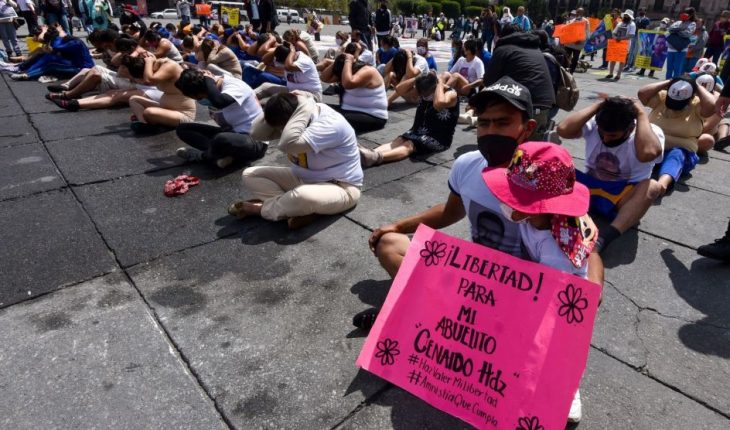Since the passage of the Amnesty Law in April last year, more than 900 inmates have formally applied for this benefit in order to be able to leave prison early, yet less than 2% received it. The rest of the cases are still pending or were rejected.
Although this law was passed in the context of the health emergency and on the grounds that it was urgent to depressurize prisons to prevent contagion, the commission responsible for approving applications has only met regularly three times in a year. Meanwhile, in the same period the prison population grew by more than 10 thousand prisoners.
Find out | The Governor’s Office announced a decree to release imprisoned people, but those measures are already in law
Official data of the Ministry of the Interior obtained by Political Animal through a request for transparency, they show that until the end of last June, 938 amnesty applications had been received that comply with the formalities set out in the procedures.
The majority of the applications, 647, are from federal inmates imprisoned for drug possession or distribution offenses, which is one of those contemplated by law as potential beneficiaries of the amnesty. The rest of the requests are for other illegalities and there are also eight cases of people of indigenous origin who argued that their processes were illegal, a situation that the law also contemplates to achieve this benefit.
Of all the applications submitted, the Amnesty Commission, which is the only body empowered to resolve cases that can potentially achieve this benefit, has considered only 38 of them to be appropriate. And of those, only 17 have been approved by a federal judge, who is the only one empowered to order or not the release of a person in prison.
This means that only 1.8% of the inmates who formally submitted their amnesty application have achieved release.
As for the other applications that the Commission approved and sent to the relevant judges, one of them was rejected for not complying with the legal requirements and the other 20 are still under analysis by the courts.
With regard to the applications submitted that have not been sent to a judge, most of them are still under analysis by the technical secretariat and the amnesty commission, with the exception of 217 cases in which it was identified that the crime committed by the prisoner does not conform to any of those covered by the aforementioned Law.
Why so few? Delays, bureaucracy and unwillingness
The Amnesty Law was passed in April 2020 in a session held expressly and with virtually no discussion in the Senate. The lawmakers rescued the initiative that had been frozen since a year earlier, arguing that it was urgent to expedite the release of inmates from prisons in the face of the advance of COVID-19 and the risks of contagion.
This, however, was not fulfilled and the situation worsened. Official data indicate that the population in the country’s prisons went from 209,53 in May 2020 to 220,647 in May 2021; a growth of more than 10 thousand inmates.
According to specialists consulted by this means, the Amnesty Law was never intended as a mechanism to depressurize prisons, since its spirit was different: to remove from prison those who should not be in it. In addition, however, there have been bureaucratic problems which have delayed its implementation.
From the outset, the creation of the commission responsible for receiving and analysing amnesty applications did not materialize until 18 June last year, that is, almost two months after the law had already been enacted. The delay was due to budgetary and policy issues.
Since that date, according to the information obtained via transparency, this commission has only met on three occasions in an ordinary way: the first on June 23, 2020 for its installation; the second on December 21, 2020; and the last one on March 29. For practical purposes, there are only two sessions where requests have been analyzed.
And although the law and the decree by which the commission was installed empowers it to convene and hold extraordinary sessions, none has been held.
“There is a clear lack of political will here. It’s pretty much just two sessions where cases have been evaluated. It is likely that next week it will meet again but even with that… three sessions in almost a year and a half speaks of the lack of intention to address this problem, “said Viridiana Valgañón, Senior Lawyer of the organization Equis Justicia
The final approval of an amnesty also requires the authorization of a federal judge called a Judge of Execution of Sanctions. But during the pandemic, the Federal Judiciary did not consider these judges as a priority, so the hearings were suspended for several weeks. This is in contrast to the control judges who are responsible for issuing pre-trial detention and who continued to operate.
As a result, the burden of hearings and backlog in the execution courts accumulated without relief having been achieved to date.
In addition to all this bureaucratic network, adds attorney Valgañón, there is the fact that the benefits of the Amnesty Law were not disseminated in prisons either, and that the wording of the law and its guidelines are confusing or incomplete.
“The procedure is opaque and unclear. You submit your request, but you never know when they are going to solve you, in how long, how they are going to communicate it to you, let alone know what to do if the answer is negative. And on top of all that the law presumes the fictitious refusal, that is, to assume that if they do not answer you it is because the answer is negative although you do not know if they actually prosecuted your case,” the lawyer said.
Because of the complexity of the process, Valgañón said that you need a lawyer to accompany the application and have a certain level of resources at hand to carry out the procedure, which already conditions access to many inmates who come from indigenous communities, or from marginalized areas and hit by poverty.
The Amnesty Law has had zero effect on the states. Although the decree establishing it established an appeal to entities to adapt their legislation and create their local laws in this area, to date none has completed this procedure.
Doubts behind new plan to free prisoners
On July 29, President Andrés Manuel López Obrador announced that he will issue a decree to release inmates from federal prisons for non-serious crimes who have not been sentenced for more than 10 years, people with chronic illnesses who are over 65 years old, and those who prove that they have been tortured, among others.
The experts consulted by Political Animal they considered that while the announcement made was positive from a human rights perspective, we should wait to know how this was intended to be carried out and its scope.
“In general, but especially during the current pandemic, any measure that allows the release of persons deprived of their liberty is positive. One of the lessons of the Amnesty Law, however, is that everything is in the details: how the measures that are intended to be applied will be drafted and how they will be operated,” said Estefanía Vela, director of the intersecta organization.
Maria Sirvent, director of the organization Documenta A.C., agreed that it is important to know how the aforementioned decree will land the operation of these releases. A fundamental point will be the universe of inmates who benefit, because he pointed out that at the federal level there are not many prisoners in pretrial detention for “non-serious crimes.”
In the case of the prisoners who suffered torture, the specialist expressed doubts that it is only with the Istanbul Protocol that the inmates are to be released. He said that this is expert evidence that is mostly practiced by the authorities themselves accused of torture, so many of the results are not entirely reliable.
He added that it will be important to know what rehabilitation plan the government is proposing for the people it intends to release, given that many of them have lost social and family contacts and their reinstatement can be complicated.
“This must be accompanied by reintegration plans and not just release for release.” What are the conditions for these people to return to their communities and what comprehensive reintegration plan is the government going to put in place? What opportunities are these people going to have once they leave? These are priority issues that we hope will be considered,” Sirvent said.
Valgañón de Equis Justicia warned that, if the new decree is not put teeth in and if there is no clear political will to, for example, land these benefits also in state prisons, we will continue with “promises that will not be fulfilled and with people who will continue to be deprived of their liberty in the midst of the pandemic and with the poor conditions in which Mexican prisons operate.”
What we do at Animal Politico requires professional journalists, teamwork, dialogue with readers and something very important: independence. You can help us continue. Be part of the team.
Subscribe to Animal Politico, receive benefits and support free journalism.#YoSoyAnimal





